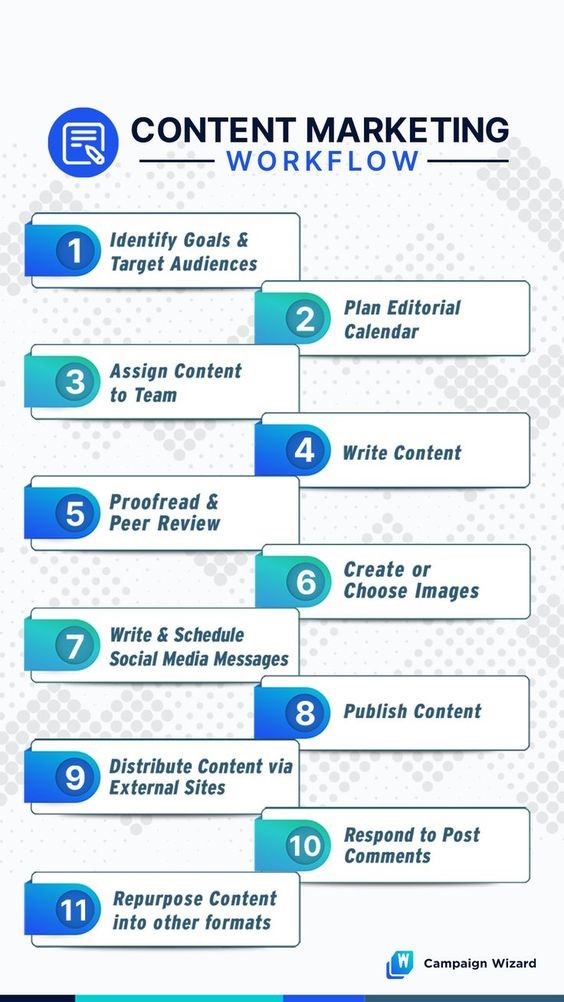What is Content Marketing?
Content Marketing is the Strategic Marketing approach focused on creating and distributing valuable, consistent and relevant content to attract and maintain a target audience.
Why Content Marketing is Important?
1. Audience Retention
2. Lead Generation & Conversion
3. Stand Out in Industry
4. Build Good Trust
5. Educate Your Audience
Types of Content Marketing
1. Online Content Marketing
2. Social Media Content Marketing
3. Infographic Content Marketing
4. Blog Content Marketing
5. Podcast Content Marketing
6. Video Content Marketing
7. Paid Ad Content Marketing
ONLINE CONTENT MARKETING
Online content marketing involves creating and sharing valuable digital content like articles, videos, and social media posts to attract and engage a target audience, driving traffic, brand recognition, and business goals achievement.
SOCIAL MEDIA CONTENT MARKETING
Social media content marketing uses compelling posts, visuals, and videos on platforms like Facebook, Instagram, and Twitter to engage audiences, boost brand presence, and encourage interactions for business success.
INFOGRAPHIC CONTENT MARKETING
Infographic content marketing employs visually appealing graphics to convey complex information succinctly, enhancing engagement and understanding across audiences, fostering effective communication and content sharing.
BLOG CONTENT MARKETING
Blog content marketing is a strategic approach that involves creating and sharing valuable, relevant blog posts to attract, engage, and convert target audiences, ultimately driving traffic and building brand authority.
POD CAST CONTENT MARKETING
Podcast content marketing leverages the power of audio storytelling to deliver valuable information, insights, and entertainment to a targeted audience, fostering brand awareness, engagement, and audience growth.
VEDIO CONTENT MARKETING
Video content marketing utilizes compelling visual storytelling to convey information, captivate audiences, and promote products or services, effectively enhancing brand visibility and audience engagement.
PAID AD CONTENT MARKETING
Paid ad content marketing involves strategically creating and promoting tailored advertisements across various platforms to reach a specific audience, driving traffic, conversions, and brand exposure through a paid distribution approach.
How does Content Marketing Works?

Content Marketing
CONTENT MARKETING EXAMPLES
1.Example of Instagram Content Marketing
2.Example of Social Media Marketing
3.Example of Infographic Content Marketing
CONTENT MARKETING STRATEGY
1.Define your Audience
2.Know your Audience
3.Keyword Research
4.Create Valuable Content
5.Diversify Content Types
6.Consistent Posting Schedule
7.Storytelling
8.Visual Appeal
9.Promotion and Distribution
10.Email Marketing
SEO
SEO, or Search Engine Optimization, By using techniques like keyword optimization, quality content creation, and technical improvements, SEO helps your website rank higher in search results, driving more organic (unpaid) traffic and attracting potential customers.
Keyword Research
Identifying Relevant Keywords: Brainstorm and compile a list of keywords that are relevant to your business. These can be single words or longer phrases (long-tail keywords).
Search Volume Analysis: Use keyword research tools to determine how often these keywords are searched for on search engines. This helps you prioritize keywords that have higher search volume.
Competition Analysis: Evaluate the competitiveness of keywords. High-competition keywords might be harder to rank for, so consider a mix of high- and low-competition keywords.
Keyword Variations: Identify variations or synonyms of your main keywords. This can help you cover a broader range of search queries.
Content Alignment: Ensure the chosen keywords align with the content you plan to create. Your content should provide valuable information related to the keywords.
User Relevance: Prioritize keywords that are relevant to your target audience and the solutions you offer. Avoid keywords that are too broad and unrelated.
Location-Based Keywords: If your business has a physical presence, include location-specific keywords to target local searches.
Trends and Seasonality: Consider seasonal trends and fluctuations in keyword popularity. Adjust your strategy accordingly.
Keyword Tools: Utilize keyword research tools like Google Keyword Planner, SEMrush, Ah refs, and M oz Keyword Explorer to gather data and insights.
Monitor and Adjust: Continuously monitor keyword performance and adjust your strategy based on changes in search trends and your website’s ranking progress.
On Page SEO
On-page SEO involves optimizing individual web pages by using relevant keywords, creating quality content, improving user experience, and properly formatting elements like headings, meta tags, and images. This enhances the page’s visibility in search engine results and provides a better experience for users.
Keyword Optimization
- Quality Content
- Meta Tags
- URL Structure
- Heading Tags
- Image Optimization
- Internal Linking
- External Linking
- Mobile-Friendly Design
- Page Load Speed
- Schema Markup
- Secure Connection (HTTPS)
- User Experience
- Readability and Formatting
Off Page SEO
Off-page SEO refers to activities conducted outside of your website to improve its online reputation and authority. This includes building high-quality backlinks from reputable sources, engaging on social media, and fostering a positive online presence. Off-page SEO helps boost your website’s credibility and search engine rankings.
How to Rank #1 on Google ?
Ranking #1 on Google requires a combination of strategic efforts and consistent optimization. Keep in mind that achieving the top spot is highly competitive and can take time.
Quality Content: Create comprehensive, valuable, and original content that addresses user intent and provides in-depth information. Content should be easy to read and well-structured.
On-Page SEO: Optimize your content with relevant keywords in titles, headings, meta descriptions, and throughout the content.
Backlink Building: Focus on natural link-building through guest posts, partnerships, and creating shareable content.
User Experience: Provide a seamless user experience with clear navigation, intuitive design, and a focus on user engagement. Lower bounce rates and longer time on site can positively impact rankings.
Social Signals: Engage on social media platforms and encourage social sharing of your content. While not a direct ranking factor, social signals can indirectly influence your site’s visibility.
Mobile Optimization: Ensure your website is responsive and works well on mobile devices, as Google considers mobile-friendliness for rankings.
Monitor Analytics: Use tools like Google Analytics and Google Search Console to track your website’s performance, monitor keyword rankings, and identify areas for improvement.
Consistency: Consistently produce high-quality content and keep your website updated. Regularly review and optimize your strategy based on changes in your industry and search algorithms.
Patience: Achieving the top rank takes time. Stay committed to your strategy and continue to refine your approach based on data and results.
Remember that the SEO landscape is constantly evolving, and there are no guarantees of reaching the #1 spot. Instead of solely focusing on ranking, prioritize providing value to your audience and meeting their needs. Over time, this user-centered approach can lead to improved rankings and increased organic traffic.
SEO Tools
- Google Search Console
- Google Analytics
- SEMrush
- Ah refs
- M oz
- Uber suggest
- Screaming Frog
- Yoast SEO
- SERP stat
- Majestic
- Buzz Sumo
- SE Ranking
- KeywordTool.io
- Cognitive SEO
- Rank Math
- Web Page Test
- GT Metrix
- ah refs Webmaster Tools
- Answer The Public
- Spy Fu
How to Drive Traffic to your Website?
To drive traffic to your website:
- Create Valuable Content: Craft informative and engaging content that addresses your audience’s interests and needs.
- Optimize for SEO: Use relevant keywords, meta tags, and proper site structure to improve search engine visibility.
- Use social media: Share your content on social platforms to reach a broader audience and encourage sharing.
- Email Marketing: Build an email list to send updates and promotions directly to interested users.
- Collaborate with Influencers: Partner with industry influencers to tap into their audience.
- Engage in Online Communities: Participate in forums and groups, sharing your expertise and linking back to your site.
- Utilize Video and Podcasting: Create visual and audio content to attract different audiences.
- Webinars and Live Streams: Host real-time events to interact with your audience.
- Paid Advertising: Invest in targeted ads on search engines and social media.
- Mobile Optimization: Ensure your site is mobile-friendly.
- Monitor Analytics: Track your traffic sources and adjust strategies based on insights.
Consistency, value, and adaptability are key to successful website traffic growth.
SEO Tips
- Keyword Research: Choose relevant keywords that match user intent.
- On-Page Optimization: Use keywords in titles, headings, and content naturally.
- Mobile-Friendly Design: Ensure your site works well on mobile devices.
- Page Speed: Optimize your site for faster loading times.
- Backlinks: Build high-quality, relevant backlinks from authoritative sites.
- User Experience: Prioritize easy navigation, readability, and good design.
- Meta Tags: Craft compelling meta titles and descriptions.
- Internal Linking: Include relevant links to other pages on your site.
- Social Signals: Engage on social media to enhance online presence.
- User Intent: Understand what users are looking for and tailor content accordingly.
Applying these tips can enhance your site’s search engine visibility and user experience.
SEO Interview Questions
Sure, here are some common SEO interview questions that you might encounter:
- Explain the difference between on-page and off-page SEO.
- What are keywords, and how do you choose the right ones for a website?
- How does a search engine work? Explain the crawling, indexing, and ranking processes.
- What is the significance of backlinks in SEO?
- How can you optimize a website for mobile devices?
- Explain the concept of “canonicalization” in SEO.
- What are some common on-page SEO factors you would consider when optimizing a webpage?
- How do you deal with a sudden drop in organic traffic for a website?
- How can you improve the website’s page loading speed?
- What are rich snippets, and how can they benefit SEO?
- How would you optimize a website for local search?
- What is the significance of the robots.txt file in SEO?
- What tools do you use for keyword research and SEO analysis?
- Can you explain the concept of LSI keywords?
- What is Google’s algorithm update, and how does it affect SE strategies?
- What is the importance of user experience (UX) in SEO?
- What are Google Webmaster Tools (now called Google Search Console), and how do you use them?
These questions cover a range of SEO concepts and practices. Be prepared to elaborate on your answers and provide practical examples from your experience if applicable.
INTERN ISHA WASNIK
(MERN Stack Developer)

